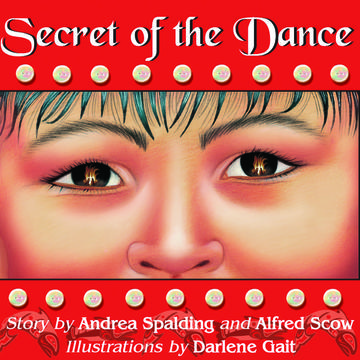- Age:
- 3 to 5
- Grade:
- p to k
- Reading age:
- 3 to 5
- Commended, CCBC Our Choice
- Short-listed, Aboriginal Children's Book of the Year nominee
"Powerful aboriginal images and symbols…are incorporated into almost all the acrylic paintings that illustrate this…fictionalized account of a signal event in the life of Alfred Scow...told in simple but evocative prose."
"Based upon a true incident, this story provides a discussion venue for discrimination and prejudice."
"An innocent perspective on a powerful act of defiance...Gait's large-scale acrylic paintings reinforce the religious dimension, infusing magic realism into the landscape and story."
"The illustrations...strikingly reflect Aboriginal imagery. The voice of the adult recalling a profound and transformative childhood moment is... immediate and credible."
"The child's view of brave adults in secret rebellion will even attract children somewhat older than the target audience."
Out of print
This edition is not currently available in bookstores. Check your local library or search for used copies at Abebooks.
Buy the e-book:
Annotations
Secrets of the Dance
In 1935, a nine-year-old boy's family held a forbidden Potlatch in faraway Kingcome Inlet. Watl'kina slipped from his bed to bear witness. In the Big House masked figures danced by firelight to the beat of the drum. And there, he saw a figure he knew. Aboriginal elder Alfred Scow and award-winning author Andrea Spalding collaborate to tell the story, to tell the secret of the dance.
This is an important picture book to share when considering cultural traditions connected to the dance curriculum. Moreover, it is a strong story of upholding Aboriginal cultural traditions and ceremonies, even in the face of persecution from the government. The book is based on the true story of one First Nations family who performed a forbidden Potlatch ceremony, despite the need to keep it a secret, and demonstrated the importance of preserving their culture. The illustrations offer readers a view of salmon hunting, and of the clothing, masks and costumes passed down from generation to generation.
Seal Song by Andrea Spalding and illustrated by Pascal Milelli
Author available for class visits.
Source: Association of Canadian Publishers. Top Grade Selection 2016.
Secret of the Dance
Although fictional, this story is based on events in the childhood of Kwick’wa’sut’eneuk elder Alfred Scow, whose childhood name was Watl’kina. In 1935 Watl’kina’s family took part in a forbidden Potlatch. They pretend to be going out fishing, but secretly prepare for the ceremony. At a small village the children are told to go to bed while the elders meet. Not content to wait, Watl’kina sneaks up to the Gookji (Big House) where he sees the characters from the old stories come to life. The illustrations are a combination of traditional and modern artwork, with traditional west coast Aboriginal designs. Includes a glossary of Kwa’kwa’la words and an historical note.
Spalding’s other works include Solomon’s Tree and the Summer of Magic Quartet. Solomon’s Tree was the First Nation Communities Read 2004 Book of the Year. Scow is a retired judge.
Source: The Association of Book Publishers of BC. BC Books for BC Schools. 2007-2008.
Secret of the Dance
Although fictional, this story is based on events in the childhood of Kwakwa’wakw Elder Alfred Scow, whose childhood name was Watl’kina. It tells the story of the day in 1935 that Watl’kina’s family took part in a forbidden potlatch. They pretend to be going out fishing, but secretly prepare for the potlatch. After sailing up a narrow inlet, they arrive at a small village where the children are told to go to bed while the Elders meet. Not content to wait, Watl’kina sneaks up to the Gookji (Big House) where he sees the characters from the old stories come to life. The illustrations combine traditional West Coast Aboriginal designs and modern artwork. The book includes a glossary of Kwa’kwa’la words as well as an historical note explaining events around the story.
Spalding’s other work includes Solomon’s Tree. Scow is a retired judge.
Source: The Association of Book Publishers of BC. Canadian Aboriginal Books for Schools. 2007-2008.
Secret of the Dance
Secret of the Dance by Andrea Spalding and Alfred Scow, with illustrations by Darlene Gait, offers a fictional story that is based on an early experience of Watl’kina, also known as Judge Alfred Scow. As a child, Watl’kina did not understand the secret whisperings between the elders that occurred after the Indian Agent visited (the government had outlawed Potlatches in 1885). Under a microscope in Alert Bay, Watl’kina’s family could not hold a Potlatch as a memorial to his grandfather. One day, his family suddenly packed up the masks and other forbidden potlatch regalia in their fishing boat. They stole off in the night up the river to Kingcome Inlet where relatives hosted a secret potlatch.
I found this book in my mailbox upon returning from teaching a course in the isolated British Columbia community of Kingcome Inlet. Scow and Spalding do not name Alert Bay and Kingcome Inlet in the story, yet I recognized the images as very similar to those I had seen on the school and Big House in Kingcome Inlet. The story mirrored a tale I had just heard from two elders who walked the village with me each morning. These women giggled as they described the warning system developed to send a message from Alert Bay to Kingcome that the Indian Agent was on his way. When I realized from the endnotes where the story originated, I was profoundly moved by the book’s authenticity.
Integration of Kwa’kwa’la words throughout the story shows cultural sensitivity to the battle First Nations face in trying to keep their languages from extinction. A short glossary further supports this. Teachers looking to support heritage studies in Grade 3 will appreciate this engaging supplement to their curriculum.
Gait’s integration of traditional and contemporary images makes this book wholly accessible to today’s children. The abalone buttons on the cover frame the eyes of a child. Mysterious flames flicker in his irises, beckoning the reader inside the story.
Source: The Canadian Children's Bookcentre. Fall 2006. Vol.29 No. 4.






